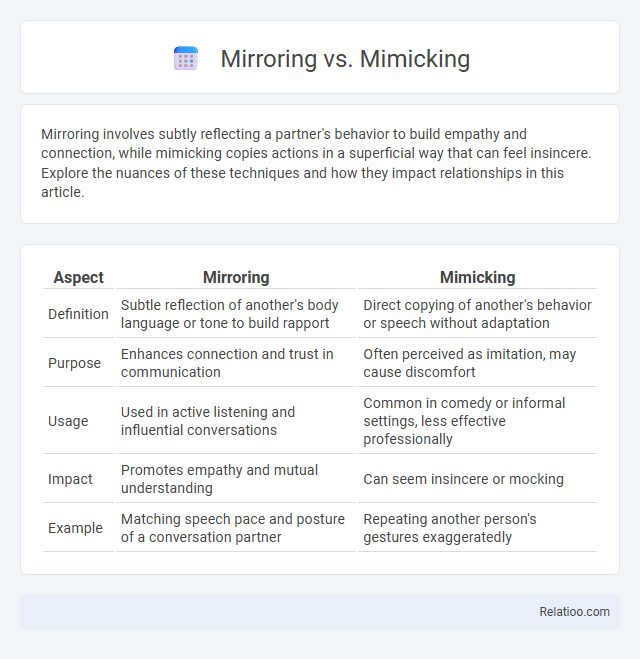Mirroring involves subtly reflecting a partner's behavior to build empathy and connection, while mimicking copies actions in a superficial way that can feel insincere. Explore the nuances of these techniques and how they impact relationships in this article.
Table of Comparison
| Aspect | Mirroring | Mimicking |
|---|---|---|
| Definition | Subtle reflection of another's body language or tone to build rapport | Direct copying of another's behavior or speech without adaptation |
| Purpose | Enhances connection and trust in communication | Often perceived as imitation, may cause discomfort |
| Usage | Used in active listening and influential conversations | Common in comedy or informal settings, less effective professionally |
| Impact | Promotes empathy and mutual understanding | Can seem insincere or mocking |
| Example | Matching speech pace and posture of a conversation partner | Repeating another person's gestures exaggeratedly |
Understanding Mirroring and Mimicking
Understanding mirroring involves subtly reflecting another person's body language, tone, or behavior to build rapport and foster connection. Mimicking, in contrast, often exaggerates or directly copies actions, which can seem insincere or mocking if not done carefully. Both techniques rely on nonverbal communication cues, but effective mirroring promotes empathy and trust, while mimicking may hinder genuine interaction.
Key Differences Between Mirroring and Mimicking
Mirroring involves subtly reflecting another person's body language, tone, or behavior to build rapport and foster connection, while mimicking often implies an overt or exaggerated imitation that can come off as mocking or insincere. Mirroring is typically unconscious and aims to create empathy by matching nonverbal cues, whereas mimicking is a conscious action that may not always result in genuine bonding. Understanding these key differences helps you use interpersonal skills effectively to strengthen communication and relationships.
Psychological Foundations of Mirroring
Mirroring in psychology involves unconscious imitation of another person's behavior, fostering empathy and social bonding by activating mirror neurons in the brain. Mimicking differs as it is often a deliberate and conscious replication of gestures or speech, lacking the deep emotional connection that mirroring provides. The psychological foundations of mirroring highlight its role in nonverbal communication, emotional attunement, and building trust within interpersonal relationships.
The Role of Mimicking in Social Interactions
Mimicking plays a crucial role in social interactions by subtly reflecting another person's behaviors, gestures, or speech patterns to create rapport and foster connection. Your ability to mimic nonverbal cues enhances empathy and helps build trust, making conversations smoother and more engaging. Unlike mirroring, which involves conscious and symmetrical imitation, mimicking often occurs unconsciously, serving as a powerful tool in social bonding and communication.
Benefits of Mirroring in Communication
Mirroring in communication enhances rapport by subtly reflecting the speaker's body language, tone, and emotions, creating unconscious trust and connection. It promotes empathy and active listening, enabling clearer understanding and more effective interactions. This technique reduces misunderstandings and fosters collaboration in both personal and professional settings.
Potential Drawbacks of Mimicking
Mimicking involves copying another person's behavior or speech patterns, which can lead to diminished authenticity and may create discomfort for both parties if perceived as insincere. Unlike mirroring, which subtly reflects another's body language to build rapport naturally, mimicking can seem forced and undermine your credibility. Your interactions risk appearing manipulative, potentially damaging trust and rapport instead of fostering genuine connection.
How to Use Mirroring Effectively
To use mirroring effectively, closely observe the other person's body language, tone, and speech patterns, then subtly replicate these cues to build rapport and foster trust. Matching gestures, posture, and energy levels creates a subconscious sense of connection without appearing forced or insincere. Practice active listening and maintain natural timing to ensure mirroring enhances communication and encourages openness in conversations.
Common Misconceptions about Mirroring and Mimicking
Mirroring and mimicking are often confused, yet they serve distinct social and psychological functions; mirroring involves subtly reflecting another's body language or emotions to build rapport, while mimicking is a direct and often exaggerated imitation of actions. A common misconception is that mimicking always aids communication, but it can be perceived as mocking or insincere, reducing trust rather than enhancing it. Understanding the nuanced role of mirroring--such as its use in psychotherapy and negotiation--clarifies its positive impact, contrasting with the often negative perception of mimicking in social interactions.
Real-Life Examples: Mirroring vs Mimicking
Mirroring involves subconscious copying of another person's body language, tone, or behavior to build rapport, such as a salesperson matching a customer's posture to create trust. Mimicking is a more deliberate and sometimes exaggerated imitation, like a comedian copying a celebrity's gestures to entertain an audience. Real-life examples highlight that mirroring fosters connection and empathy, while mimicking often serves humorous or critical purposes.
Choosing the Right Approach for Better Connections
Mirroring involves subtly reflecting another person's body language and tone to build rapport, while mimicking copies behaviors more overtly and can feel insincere. Choosing the right approach depends on context and relationship dynamics, as mirroring fosters unconscious bonding and mimicking risks appearing inauthentic. Effective communication leverages mirroring for genuine connections, balancing empathy with respect for personal boundaries.

Infographic: Mirroring vs Mimicking
 relatioo.com
relatioo.com